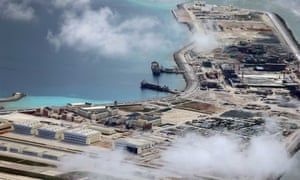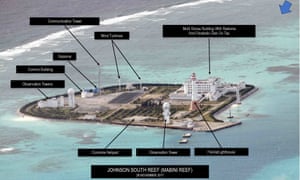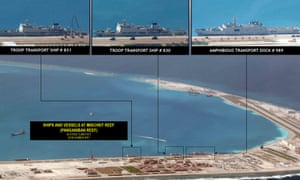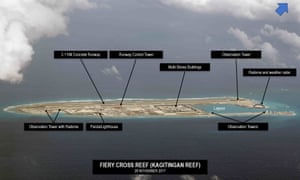By Tom Phillips
 Beijing has been accused of building “island fortresses” in the South China Seaafter a newspaper in the Philippines obtained aerial photographs offering what experts called the most detailed glimpse yet of China’s militarisation of the waterway.
Beijing has been accused of building “island fortresses” in the South China Seaafter a newspaper in the Philippines obtained aerial photographs offering what experts called the most detailed glimpse yet of China’s militarisation of the waterway.
The Philippine Daily Inquirer said the surveillance photographs – passed to its reporters by an unnamed source – were
mostly taken between June and December last year and showed Chinese construction activities across the disputed Spratly archipelago between the Philippines and Vietnam.
mostly taken between June and December last year and showed Chinese construction activities across the disputed Spratly archipelago between the Philippines and Vietnam.
Brunei, China, Malaysia, the Philippines, Taiwan and Vietnam have overlapping claims in the region.
The Inquirer said the images showed an “unrestrained” building campaign designed to project Chinese power across the resource-rich shipping route through which trillions of dollars of global trade flows each year.
FacebookTwitterPinterest Installations on Johnson South Reef. Photograph: Inquirer.net/Philippine Daily Inquirer
 Some photographs show cargo ships and supply vessels, which the newspaper said appeared to be delivering construction materials to the China-controlled islands.
Some photographs show cargo ships and supply vessels, which the newspaper said appeared to be delivering construction materials to the China-controlled islands.
Others show runways, hangars, control towers, helipads and radomes as well as a series of multistorey buildings that China has built on reefs such as Fiery Cross, Subi, Mischief, McKennan, Johnson South, Gaven and Cuarteron.
The Inquirer described the reefs as “island fortresses”. Bonnie Glaser, an expert in Asia-Pacific security issues from the Center for Strategic and International Studies, called the images “the most complete, detailed batch of aerial pics available” of China’s military outposts in the South China Sea.
However, both Beijing and Manila sought to play down the significance of the images.Q&A
What is the South China Sea dispute?Show
Ties between the two Asian countries have warmed since Rodrigo Duterte, the Philippines president, took power in 2016 and set about forging a lucrative new alliance with China during a four-day state visit to Beijing.
 FacebookTwitterPinterest Images from the Philippine Daily Inquirer showing Mischief Reef. Photograph: Inquirer.net/Philippine Daily Inquirer
FacebookTwitterPinterest Images from the Philippine Daily Inquirer showing Mischief Reef. Photograph: Inquirer.net/Philippine Daily Inquirer
Responding to questions about the photographs, the presidential spokesman, Harry Roque, told reporters: “[The region has] long been militarised. And the question is, what can we do?”
He reportedly added: “What do you want us to do? We cannot declare war.”
Opposition figures hit back, accusing Duterte’s administration of betraying their “sacred core duty” to defend their country’s territory.
Experts interviewed by China’s Communist party press also shrugged off the photographs, suggesting they showed mostly civilian installations.
“Civilian facility construction is the major focus of the South China Sea islands building and the portion of defence deployment is relatively small,” Chen Xiangmiao, from the state-run National Institute for South China Sea Studies, told the Global Times.
Another Chinese expert, Zhuang Guotu, accused foreign journalists of “hyping” Beijing’s activities in the South China Sea, but added: “China has the right to build whatever it needs within its territory.” Zhuang claimed China’s military deployment was not for military expansion, but about defending its security and interests.
In December a report claimed China had created military facilities about four times the size of Buckingham Palace on contested South China Sea islands.
Since you’re here …
… we have a small favour to ask. More people are reading the Guardian than ever but advertising revenues across the media are falling fast. And unlike many news organisations, we haven’t put up a paywall – we want to keep our journalism as open as we can. So you can see why we need to ask for your help. The Guardian’s independent, investigative journalism takes a lot of time, money and hard work to produce. But we do it because we believe our perspective matters – because it might well be your perspective, too.
I appreciate there not being a paywall: it is more democratic for the media to be available for all and not a commodity to be purchased by a few. I’m happy to make a contribution so others with less means still have access to information.Thomasine F-R.
If everyone who reads our reporting, who likes it, helps fund it, our future would be much more secure. For as little as £1, you can support the Guardian – and it only takes a minute. Thank you.

No comments:
Post a Comment